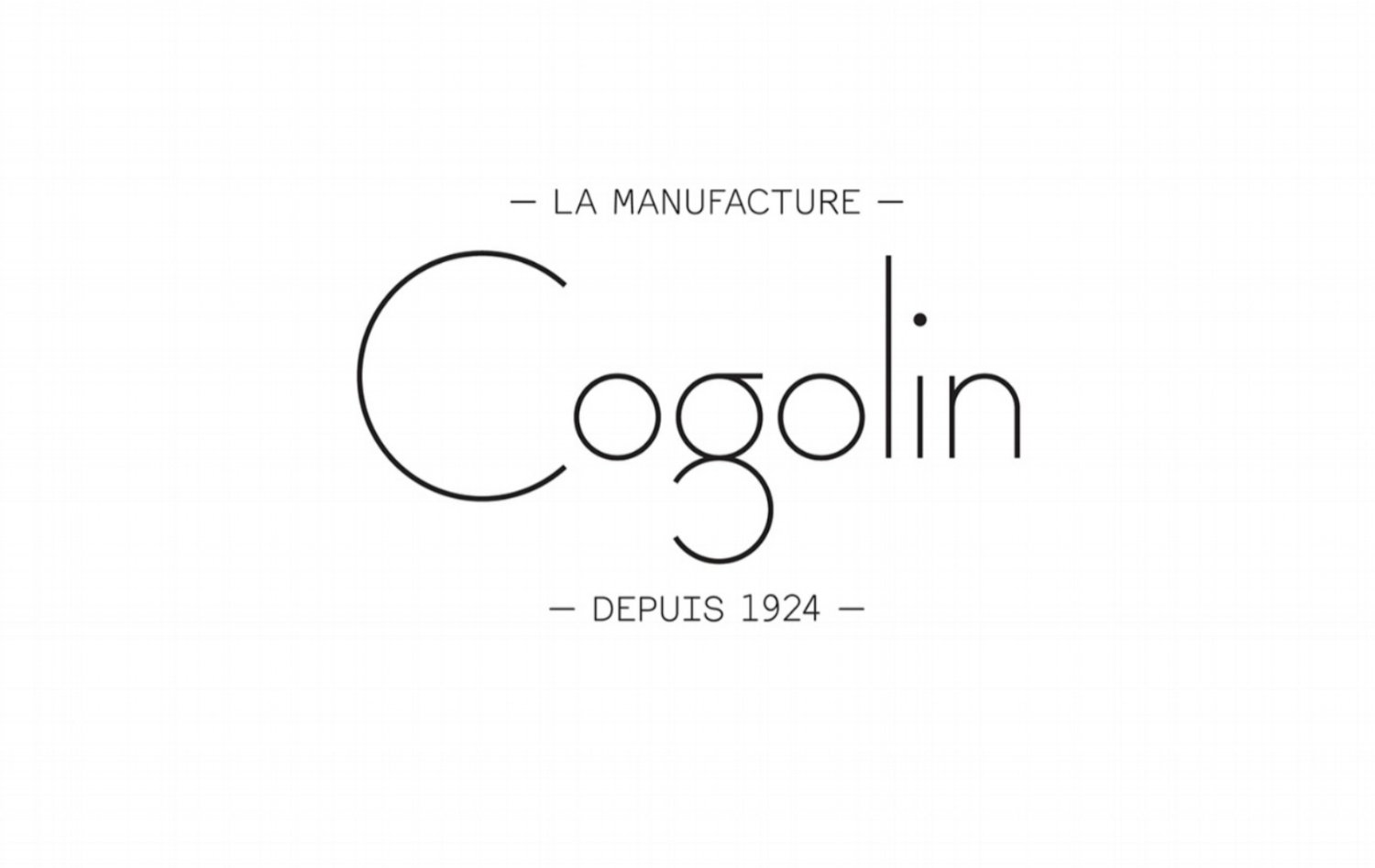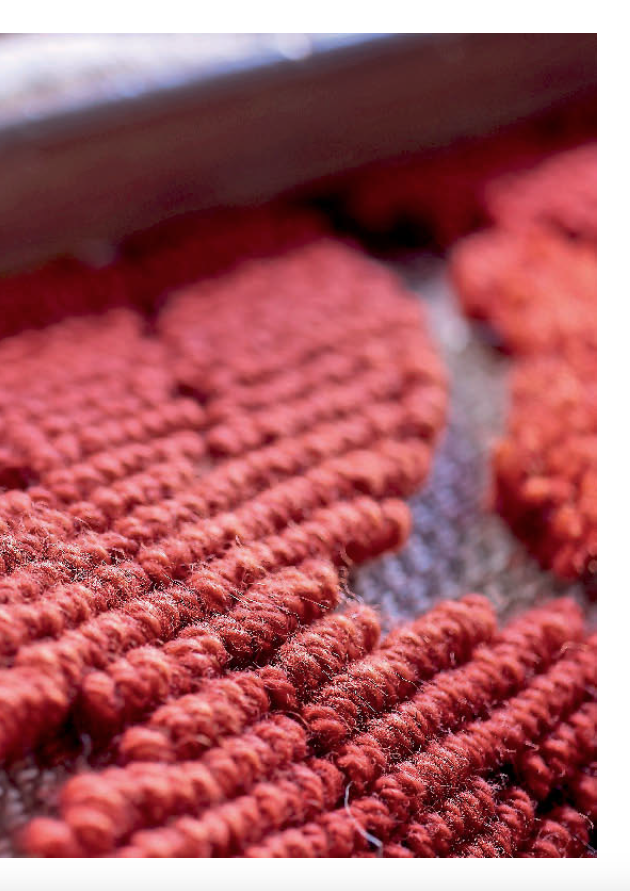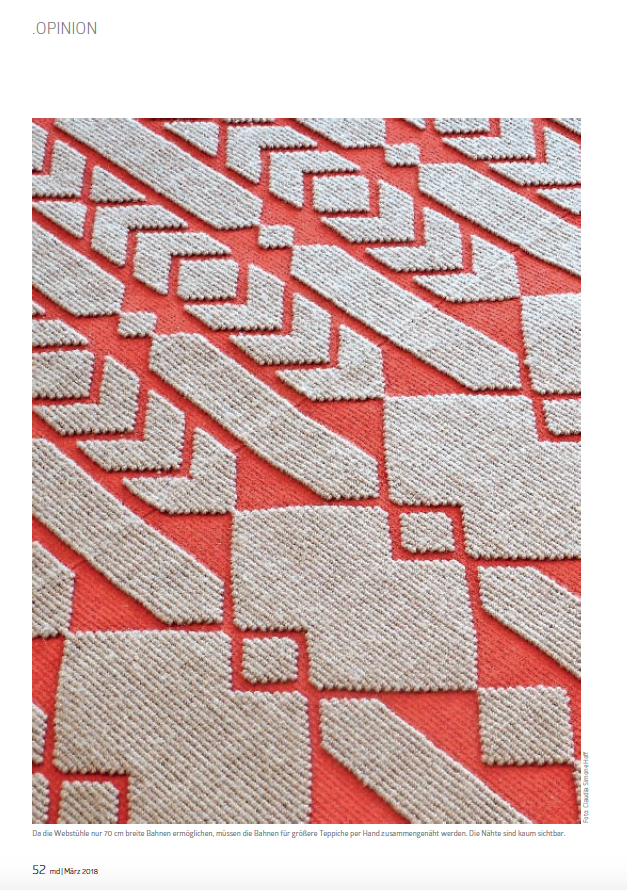HAND-WOVEN CARPET MILL IN FRANCE LA MANUFACTURE COGOLIN
FRENCH TOUCH
Hand-made rugs are en vogue again. They satisfy the desire for individuality, uniqueness and sustainable luxury. Cogolin’s manufactory in Southern France shows how traditions can be future-proofed.
Photo: Eric Laignel
Author Claudia Simone Hoff
Cogolin, a city with a population of just 12,000, is not far from Saint-Tropez. There, an unimposing exterior conceals a real gem: La Manufacture Cogolin. Rugs have been hand-woven here since 1924, and even hand-knotted before then. For a long time, the manufacture seemed doomed to closure. Five employees tried to keep the company afloat and maintain the traditions with scarce financial resources. The enterprise was finally rescued in 2010 by a Hong Kong based company. House of Tai Ping – a privately-owned carpet company – took over the manufacture, refurbished the buildings and hired new staff. To professionalise the processes, they turned to the former director of the manufacture, who worked on processes and methods. External consultants from the carpet industry were also hired.
Photo: Eric Laignel
Captions:
Cogolin uses Jacquard weaving looms from the 19th century again. The carpets are characterised by three-dimensional woven patterns.
Cogolin’s revival was perfectly timed, as more and more consumers appreciate artisanal crafts and are willing to spend money on them. “Many people want things that are not available everywhere,” says Sarah Henry, managing director of the manufacture. It is no surprise that these rugs are back in fashion today. They are unique, hand-made pieces, refreshingly different from the mass-produced mainstream products. They get their charm from visible signs of the manufacturing process, the little flaws, the imperfections. Also: in times of all-encompassing mechanisation, fast-paced changes, perceived social indifference, more and more people are looking for warmth, tactile sensations and longevity. Cogolin is a prime example of what makes hand-made rugs so attractive. In the weaving mill, wooden Jacquard looms from 19th century stand side-by-side. As glamorous as the French label designs may seem, a lot of work goes into them.
“Many people are on a quest for something distinctive.” Sarah Henry
Few people have what it takes to be carpet weavers, explains Sarah Henry while walking through the production facility. Weavers must not be too tall, yet must be resilient and patient. An experienced weaver can produce at least 2.5 metres of rug each day. However, it is difficult to find workers, adds the mill manager. The working conditions are tough: it can take years to acquire the skills required to weave a rug with a complicated pattern, and the starting salary is based on the French minimum wage. Some employees come from families where the craft of weaving has been passed on from generation to generation.
With its local production, the manufacture in Southern France takes a different approach to labels like Jan Kath, Rug Star or Nanimarquina. Whereas they only create the designs, and then have the rugs made in Nepal, India or Pakistan, the rug weaving mill in Cogolin offers the entire design and manufacturing process from a single source. “We have a special style here. Our woven rugs are characterised by three-dimensional weaving patterns and virtually invisible seams,” is Henry’s description of the Cogolin code.
DESIGN AND CRAFT The woven rolls are approximately 70 cm wide, are adjusted in length and then meticulously hand-stitched together. The manufacture’s attic is full of huge books of samples which Creative Director Jean-Pierre Tortil searches for treasures to be revived. For example, this was the case for Christian Bérard’s ‘Idylle’ design or the ‘Modernists’ collection. They are both from the 1930s and are hand-knotted in Nepal. Tortil also commissions external designers like India Mahdavi and Jason Miller, in keeping with the mill’s tradition, as it has always been avant-garde and worked with artists like Jean Cocteau. The French firm produces to order only, so that every customer can choose the colours, materials and patterns themselves – whether for individual rugs or wall-to-wall carpets. The price is based on various parameters, such as the complexity of the pattern, and charged by the metre.
After touring the weaving mill, we sit together in the showroom, enjoy a French lunch and talk about the carpet samples hanging in metal baskets. We agree: Cogolin carpets impress with tradition and artisanal methods. They can be designer objects or art. They tell stories, both from the past and the here and now. And they are so expressive that you never want to be without them again.
52 md | March 2018
Photo: Claudia Simone Hoff
Captions:
As the weaving looms only allow 70 cm-wide rolls, the rolls must be handstitched together to produce larger rugs. The seams are virtually invisible.
In Focus
La Manufacture Cogolin produces hand-woven rugs with elaborate patterns at its location in Southern France.
Short interview with Director Sarah Henry and additional photos.
info.md-mag.com/
Cogolin







